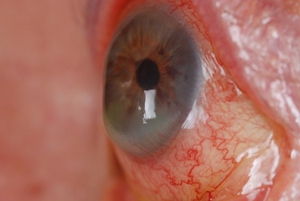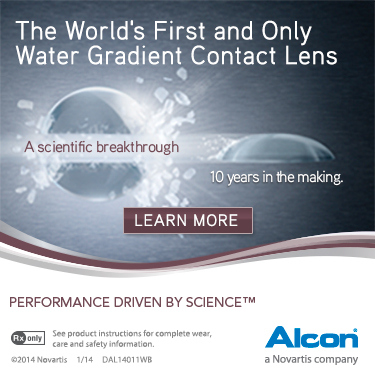

|
The LipiFlow procedure is a relatively new medical device used to treat meibomian gland dysfunction. There is a thermal pulsation unit that is used to help express the clogged and backed-up meibomian glands, particularly associated with posterior blepharitis. I've heard mixed results from the field on the system in that it works for some, but not all patients. What I have not heard much of is its use in the field with contact lens wearing patients. If you have experience of using the system in the contact lens wearing population, we would love to hear from you. Please contact us at cltoday@pentavisionmedia.com to share your experiences.
|

|
The British Contact Lens Association (BCLA) has launched its first mobile app, ahead of its flagship Clinical Conference & Exhibition in June. The BCLA
free mobile app is designed to enhance the experience of BCLA members and conference delegates alike.
The BCLA app is iPhone and Android compatible and provides instant access to the conference program, speaker information, exhibition and sponsor details,
venue, maps and floorplans; quick links to the BCLA website for travel, accommodation, social events and contacts; access to social networks such as
Twitter and Facebook; in-box for the latest updates; favorites tool in the ‘My event’ area; and exhibitor listings including product details and the
opportunity to contact suppliers prior to the event. The app will be updated at various stages in the lead-up to the conference as well as incorporating
additional features. These will include, for instance, downloadable abstracts, venue maps and program updates.
The BCLA mobile app is now available to download for free on the Google Play Store for Android and the Apple iTunes Store for iOS devices.
|
|
Johnson & Johnson Vision Care is once again offering a complimentary educational brochure titled "Eye Health and Allergies" to provide patients with
useful information on how eye allergies occur, common signs and symptoms, and practical advice on how to treat eye allergies. This brochure also includes
helpful information about eye allergies and contact lenses, including advice on the benefits of daily disposable contacts.
Digital copies of the brochure are available for download from the Patient Education section of www.ACUVUEProfessional.com. To receive bulk copies, email the request with your name and mailing address
to eyeallergybrochure@rprny.com.
|
|
TearLab Corporation has signed a nonbinding term sheet to purchase the assets of the OcuHub business unit from AOAExcel, Inc., the for-profit subsidiary of
the American Optometric Association (AOA). Terms were not disclosed and the acquisition is expected to close in March.
OcuHub, powered by AT&T and Covisint, is a technology platform designed to connect eyecare practitioners, patients, healthcare organizations and
payers. Barry Barresi, OcuHub CEO and former executive director of the AOA, said that along with the efficiency of the OcuHub network, the OcuHub "app
store" will provide access to cloud based IT tools with the goal of improving clinical work flows and clinical outcomes.
|
|
Alcon has tapped Carla Mack, OD, MBA, FAAO, as director of professional and clinical support for U.S. Vision Care. Dr. Mack, a former editor of Contact Lenses Today and Contact Lens Spectrum, will provide clinical and technical expertise, and help set the company's professional
communications strategy.
Dr. Mack previously was the Global Director of Medical Affairs and the Global Director of Professional Marketing at Bausch + Lomb. She was a faculty member
at The Ohio State University College of Optometry where she taught courses in glaucoma management, specialty contact lenses and practice management. She is
a Fellow in the American Academy of Optometry and a Diplomate in the Section on Cornea, Contact Lenses and Refractive Technologies.
|
|
The American Optometric Association (AOA) Foundation invites practitioners to participate in the "Save Your Vision Month" in March. The AOA Foundation has
a new campaign kit for 2014 with new Optometry Cares wristbands, stickers, balloons, posters and more available for eyecare practices.
"Save Your Vision Month" is sponsored by the American Optometric Association to remind Americans of the importance of eye health and regular exams. It
takes place from March 1 to March 31. Practitioners are invited to participate by donating a percentage or a day of exam fees; donating $2 to $5 per frame
sold or exam during the month of March; or purchasing a Save Your Vision Month Kit for $25. The kit includes 25 wristbands, posters, stickers, balloons and
other promotional material.
To receive more information contact the AOA Foundation by email at foundation@aoa.org or visit aoafoundation.org.
|

|
|

|
|

The eye pictured here underwent LASIK 10 years prior to the time this photo was taken. Five years afterwards this eye developed ectasia. Last year, hydrops developed (see the cloudy grey area in the inferior section of the cornea). Patient is now wearing a scleral lens which is providing him with 20/40 VA.
We thank Dr. Boshnick for this image and we welcome photo submissions from our other
readers! It is easy to submit a photo for consideration for publishing in Contact
Lenses Today. Simply visit
http://www.cltoday.com/upload/upload.aspx to upload your image. Please
include an explanation of the photo and your full name, degree or title and city/state/country.
^ Back to top
|


|

|

|
OCULAR SURFACE UPDATE
Katherine M. Mastrota,
MS, OD, FAAO
|

|

|

|

|
|
Caffeine
It has been demonstrated that topically applied xanthines can stimulate tear production---caffeine is a xanthine.1 In 2002, a report from Moss et al. demonstrated that caffeine use was associated with a lower age-and sex-adjusted prevalence of dry eye.2 A subsequent study by Arita et al. reported that tear volume was increased in patients after caffeine consumption.3 Just published in Optometry and Vision Science is a study on ingested caffeine and its effect on tear secretion.4
In an examiner-masked, placebo-controlled, crossover experimental model, the effect of caffeine intake on tear secretion was studied in 41 healthy volunteers aged 20 to 26 years. Participants were randomly assigned into two groups, A and B, to receive two different treatments in two sessions. Subjects in group A were exposed to 5.0 mg/kg body weight of caffeine dissolved in 200 mL of water on their first visit, whereas those in group B were exposed to 200 mL of water. On the second visit, however, the order of treatment was reversed. Schirmer 1 scores were measured repeatedly at 45, 90, 135, and 180 minutes after treatment. The baseline Schirmer 1 scores were compared with post treatment scores.
Results of the study showed that Schirmer 1 scores increased after caffeine intake. The increase was statistically significant at 45 and 90 minutes after caffeine intake. It was also noted that there was no influence of gender in caffeine's effect on tear secretion. Thus, it appears that orally ingested caffeine appears to stimulate tear secretion in healthy non-dry eye subjects. Should we suggest a caffeinated beverage for our patients? Certainly no guidelines exist, however limiting caffeine intake for its diuretic properties may be an unnecessary restriction.
1. Gilbard JP,Rossi SR, Heyda KG, Dartt DA. Stimulation of tear secretion and treatment of dry-eye disease with 3-isobutyl-1-methylxanthine. Arch Ophthalmol.1991;109:672-676.
2. Moss SE, Klein R, Klein BE. Prevalence of and risk factors for dry eye syndrome. Prevalence of and risk factors for dry eye syndrome. Arch Ophthalmol. 2000 Sep;118(9):1264-8.
3. Arita R, Yanagi Y, Honda N, Maeda S, Maeda K, Kuchiba A, Yamaguchi T, Yanagihara Y, Suzuki H, Amano S. Caffeine increases tear volume depending on polymorphisms within the adenosine A2a receptor gene and cytochrome P450 1A2. Ophthalmology. 2012 May;119(5):972-8.
4. Osei KA, Ovenseri-Ogbomo G, Kyei S, Ntodie M. The effect of caffeine on tear secretion. Optom Vis Sci. 2014 Feb;91(2):171-7
^ Back to top
|
|
Hydrogen Peroxide Contact Lens Solution and the TSA
Last weekend, at a conference in Orlando, one of the contact lens solution manufacturers offered me a 12 oz. bottle of their new hydrogen peroxide solution. I almost turned it down, since it was greater than 3.4 oz. in volume and I did not want to check my bag with the airline. I did accept it, considering it an experiment with the Transportation Security Administration’s (TSA) “over-the-counter medication” policy. I declared the solution at checkpoint. The TSA agent asked me to place it in the bin next to my clear, quart-sized bag and it went down the conveyer belt and through the x-ray machine, no questions asked.
TSA policy states that, “Medications, baby formula and food, and breast milk are allowed in reasonable quantities exceeding three ounces and are not required to be in the zip-top bag. Declare these items for inspection at the checkpoint. Officers may need to open these items to conduct additional screening.”1
Because the TSA classifies hydrogen peroxide as a “hazardous material that is permitted aboard an aircraft,” getting the solution past the checkpoint may not always be this easy.2 Placing it in checked baggage would be the safest mode of action. As their website states, “The final decision rests with TSA on whether to allow any items on the plane.”3
1. http://www.tsa.gov/traveler-information/3-1-1-carry-ons
2. http://www.cltoday.com/issues/CLToday_071512.htm
3. http://apps.tsa.dhs.gov/mytsa/cib_results.aspx?search=hydrogen+peroxide
^ Back to top
|

|

|
|
Effect of Desiccating Stress on Mouse Meibomian Gland Function
|
|
Mice exposed to standardized desiccating environmental stress to induce dry eye-like symptoms have been used as a model to study the underlying mechanisms of evaporative dry eye. While studies have shown marked inflammatory and immune changes, the effect of such stress on meibomian gland function remains largely unknown. The authors sought to evaluate the effects of desiccating stress on meibocyte proliferation and meibum quality.
Ten mice were treated with scopolamine and subjected to a drafty low humidity environment (30-35%). Five and ten days after treatment, eyelids were harvested and cryosections stained with Ki67 antibody to identify cycling cells. Sections were also imaged using stimulated Raman scattering (SRS) microscopy to characterize the gland compositional changes by detecting the vibrational signatures of methylene (lipid) and amide-I (protein).
Desiccating stress caused a 3-fold increase in basal acinar cell proliferation from 18.3 ± 11.1% in untreated mice to 64.4 ± 19.9% and 66.6 ± 13.4% after 5 and 10 days exposure, respectively (P < .001). In addition, SRS analysis showed a wider variation in the protein-to-lipid ratio throughout the gland, suggesting alterations in meibocyte differentiation and lipid synthesis.
The authors concluded that these data are consistent with a model that a desiccating environment may have a direct effect on meibomian gland function, leading to a significant increase in basal acinar cell proliferation, abnormal meibocyte differentiation, and altered lipid production.
Suhalim JL, Parfitt GJ, Xie Y, De Pavia CS, Pflugfelder SC, Shah TN, Potma EO, Brown DJ, Jester JV. Effect of desiccating stress on mouse meibomian gland function. Ocul Surf. 2014 Jan;12(1):59-68. Epub 2013 Oct 18.
|
|
|

|
|
A Proud Supporter of

Important Links:
To report adverse contact lens reactions visit:
http://www.accessdata.fda.gov/scripts/medwatch/ or call (800) FDA-1088.
To report possible grievances related to the Fairness to Contact Lens Consumers
Act or associated Contact Lens Rule visit:
https://www.ftccomplaintassistant.gov/.
CLToday Services:
Subscribe;
Unsubscribe; Submit Clinical
Image
Submit news to cltoday@pentavisionmedia.com.
Send your comments and fitting tips to
cltoday@pentavisionmedia.com. Please include your full name, degree or title
and city/state/country.
For more information on Contact Lenses Today including archives of previous
issues, please visit our website at www.cltoday.com.
For the latest articles on contact lenses, important clinical information and helpful
tools related to the contact lens practice visit the Contact Lens Spectrum
website at www.clspectrum.com.
© 2024 All Rights Reserved Contact Lenses Today and CLToday
are registered trademarks of:
PentaVision LLC, 321 Norristown Road, Suite 150, Ambler, PA 19002 | 215-646-8700
© 2024 PentaVision LLC All Rights Reserved.
|

|
|
|



















